How to Make Pastrami at home! This nitrate-free, refined sugar-free recipe tastes even better than store-bought pastrami.
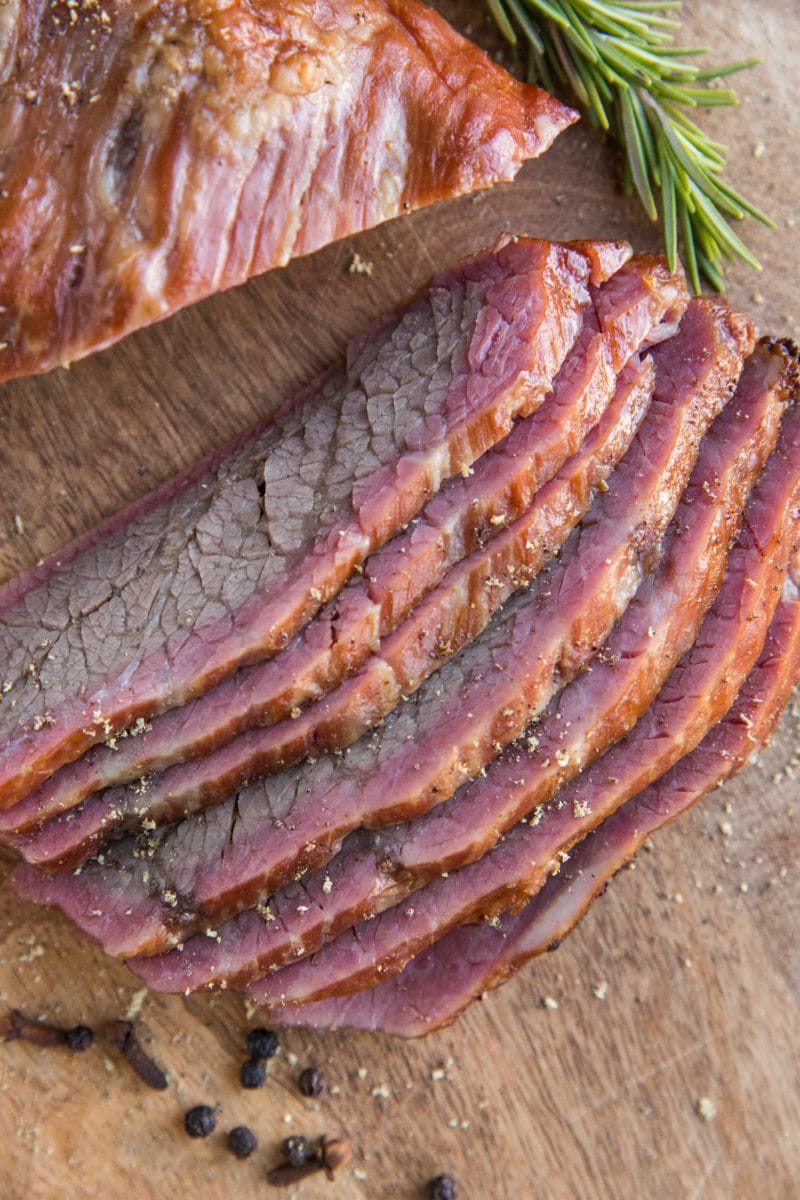
Reuben lovers, have you ever tried to make homemade pastrami?
So long as you enjoy a good kitchen project, it’s guaranteed to light up your life!
If you read my tutorial a couple of years ago on How to Brine Corned Beef, you’re already familiar with the process.
I make both corned beef and pastrami nitrate-free and refined sugar-free.
The nitrates in pastrami come from pink curing salt, which contains a little over 6% sodium nitrite, and the rest is regular table salt.
If you’re looking to avoid nitrates or refined sugar, or if you simply enjoy curing meat at home, this nitrate-free pastrami recipe is for you!
Because the meat needs to brine for 5 to 7 days, be sure to make any necessary preparations ahead of time in case you’re wanting the pastrami to be finished by a certain date.
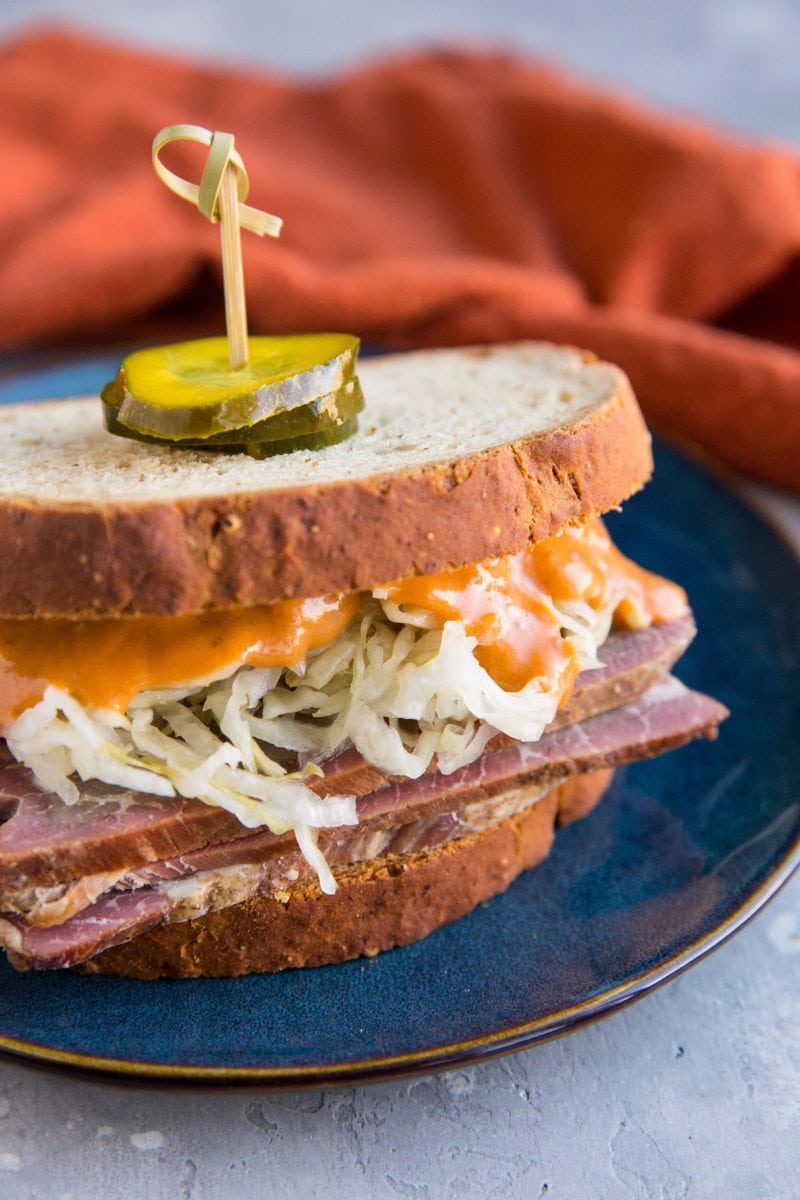
What is Pastrami?:
Pastrami is a cured beef, which is brined then seasoned and cooked on a smoker, then steamed. It originates from Romania and was invented before refrigeration as a way to preserve meat.
Pastrami is often sliced thinly after it has chilled and is customarily used in sandwiches.
The classic Reuben with rye bread, sauerkraut, Swiss cheese, and Russian dressing is an iconic application for pastrami. In addition, hot pastrami sandwiches with just toasted bread, pastrami, and cheese is a true delight.
Traditionally, pastrami is smoked or steamed for cooking. If you own a smoker, this is a great recipe to put it to use! If you want to bake the pastrami in the oven, I have included instructions for that as well.
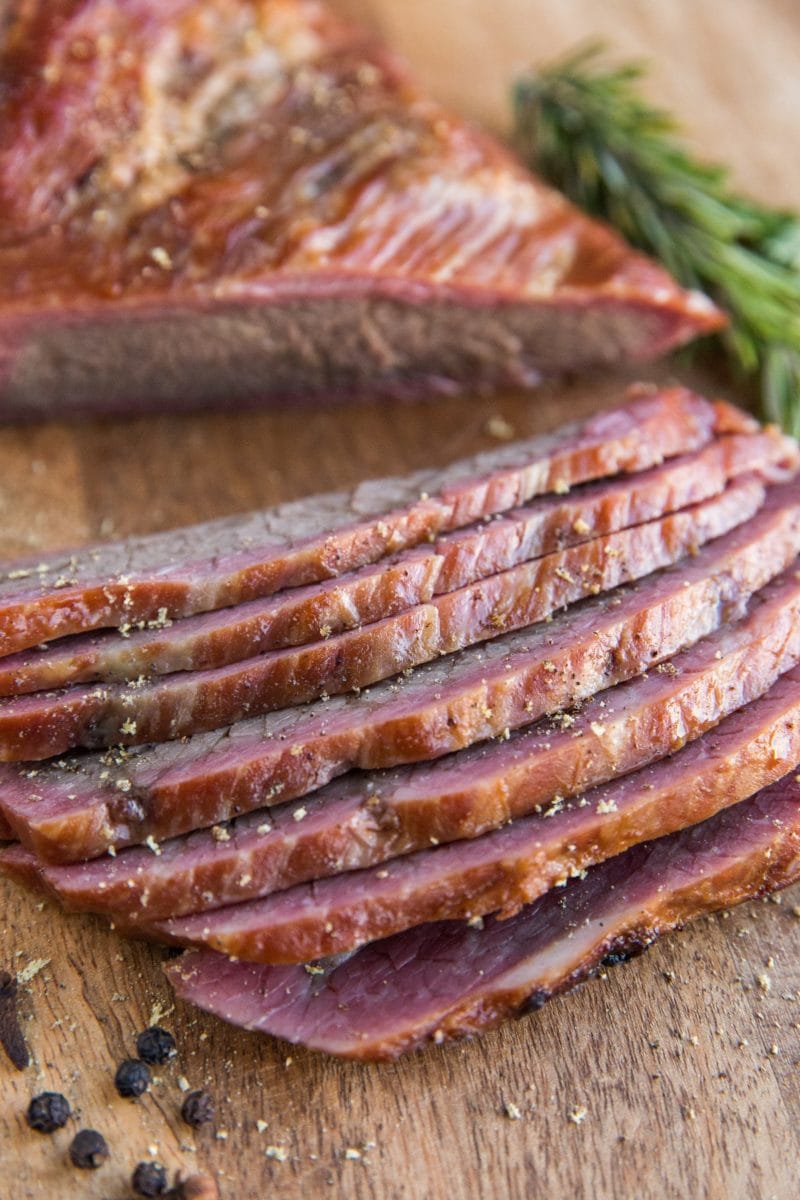
What Type of Beef to Use for Pastrami:
Pastrami is traditionally made with beef brisket or shoulder roast, but I learned Tri Tip works just as well. The goal is to use a large, boneless fatty roast, with plenty of intramuscular fat marbling.
Difference Between Corned Beef and Pastrami:
The main difference between corned beef and pastrami is how they are cooked. As previously mentioned, pastrami is smoked then steamed, whereas corned beef is boiled.
Both are brined beef roasts and both use very similar (if not the same) spices for brining. It’s customary to rub the roast in more spices before smoking it in the case of pastrami, where corned beef is usually boiled in a broth with spices.
Because of the difference in cooking methods, pastrami turns out with a classic firm deli meat texture, whereas corned beef has a very tender, often shredded texture.
If one wanted to make pastrami without going through the brining process, one could simply purchase a pre-brined corned beef brisket and follow the traditional cooking method for pastrami.
While making homemade pastrami requires some forethought and planning, the process itself is actually quite simple.
Here are the steps!
Three Easy Steps to Making Homemade Pastrami:
Step 1: Make the brining liquid
Step 2: Brine the beef for 5 to 7 days
Step 3: Cook the beef on the smoker or in the oven
So let’s break it down!
How to Make Pastrami:
Step 1: Prepare the Brine:
First, we need to gather spices for our brine. We need whole mustard seed, juniper berries, black peppercorns, whole cloves, coriander seed, red pepper flakes, and bay leaves.
This combination of spices is a customary blend used in brining beef for corned beef or pastrami.
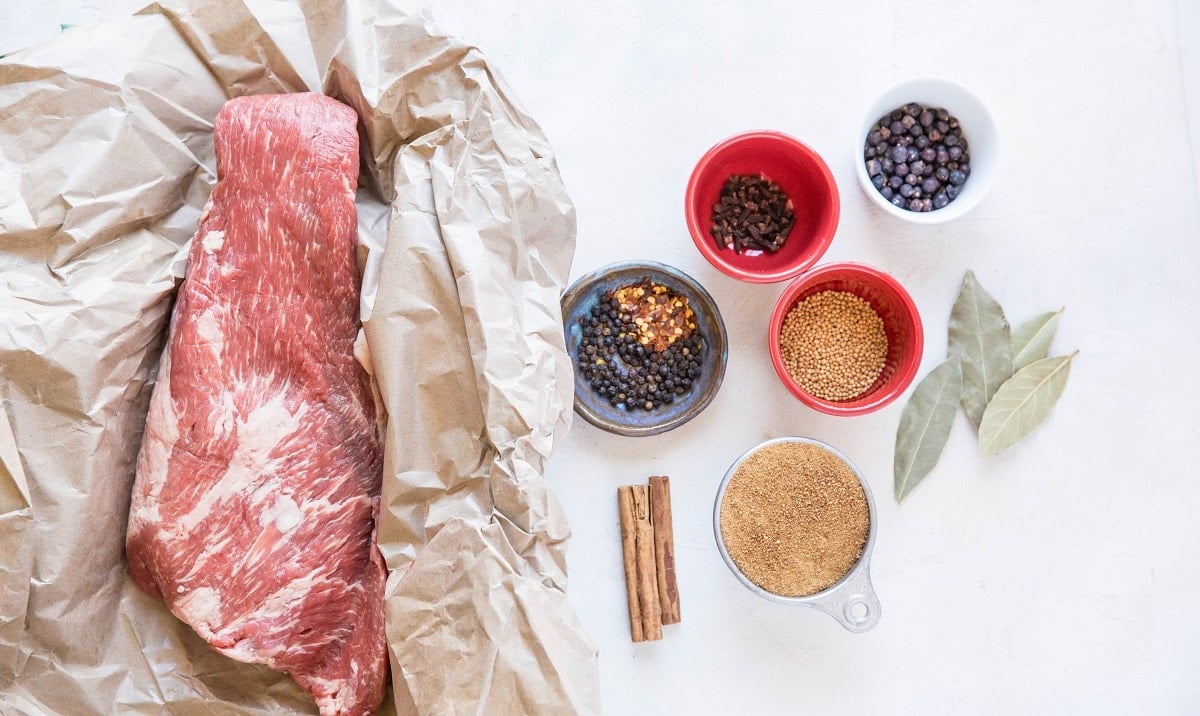
You can choose to either purchase the individual spices needed to make a pickling spice blend, or you can buy pickling spice that is premade from the store.
Do note that store-bought pickling spices are not all alike and some may contain spices you don’t love. Just be sure to read the ingredients before making your selection.
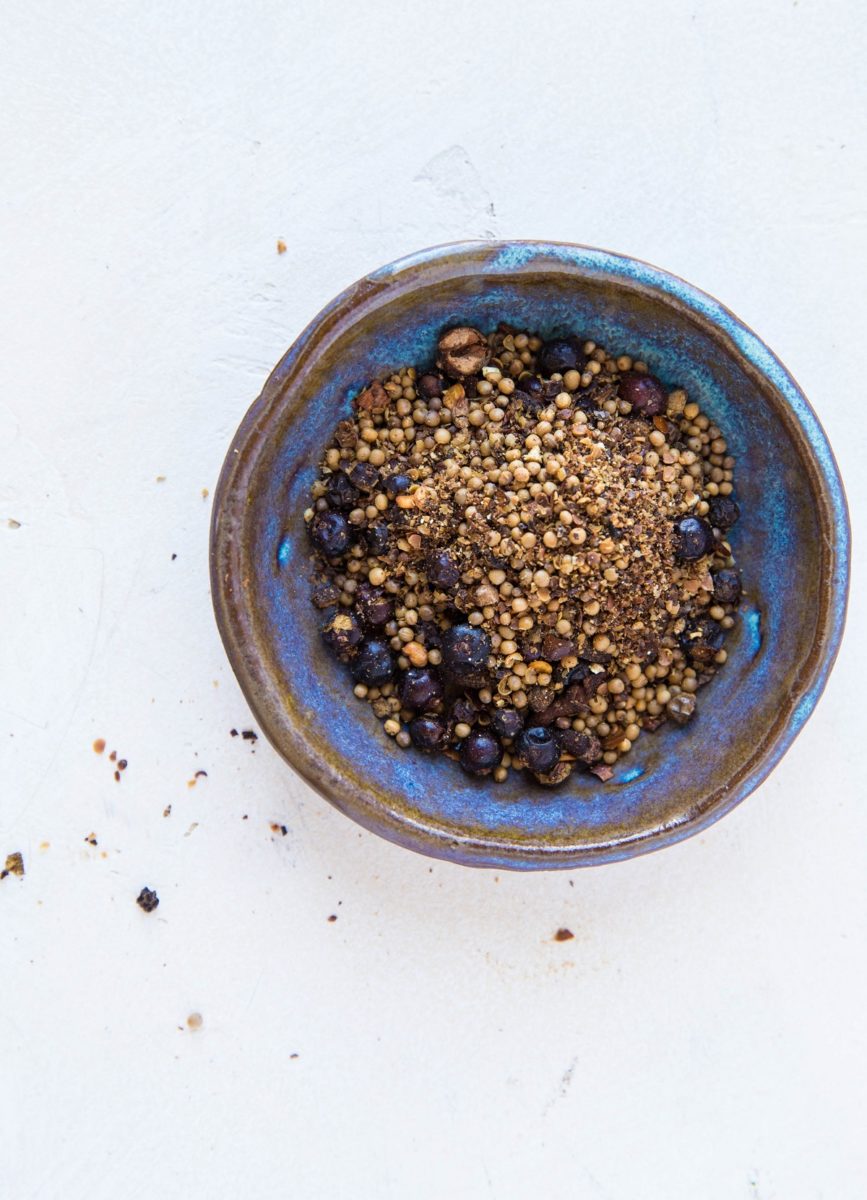
Toast the spices in a small skillet or pot over medium-low to medium heat for 1 to 2 minutes, stirring occasionally. This process helps enhance the flavors of the spices so that the brine works magic on flavoring the beef.
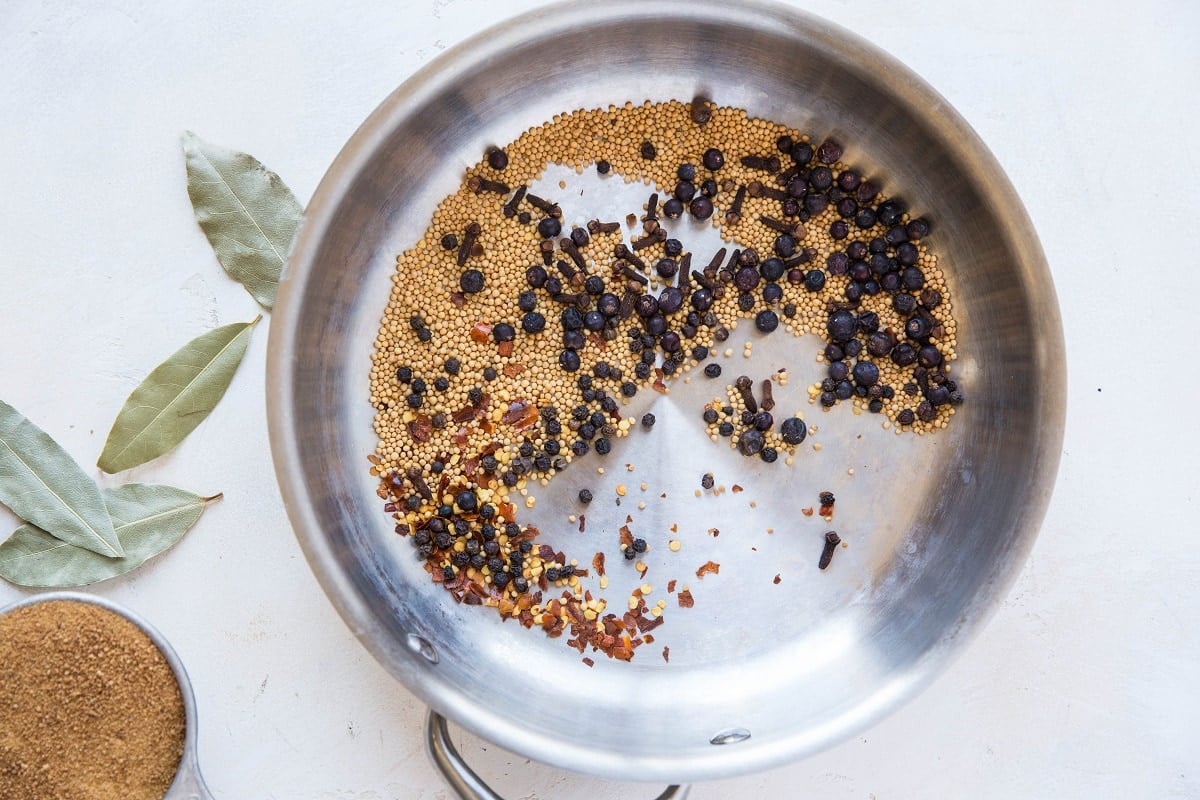
Transfer spices to a mortar and pestle and grind – it’s okay if they remain whole. Crushing them helps release the flavor but they don’t need to be finely ground.
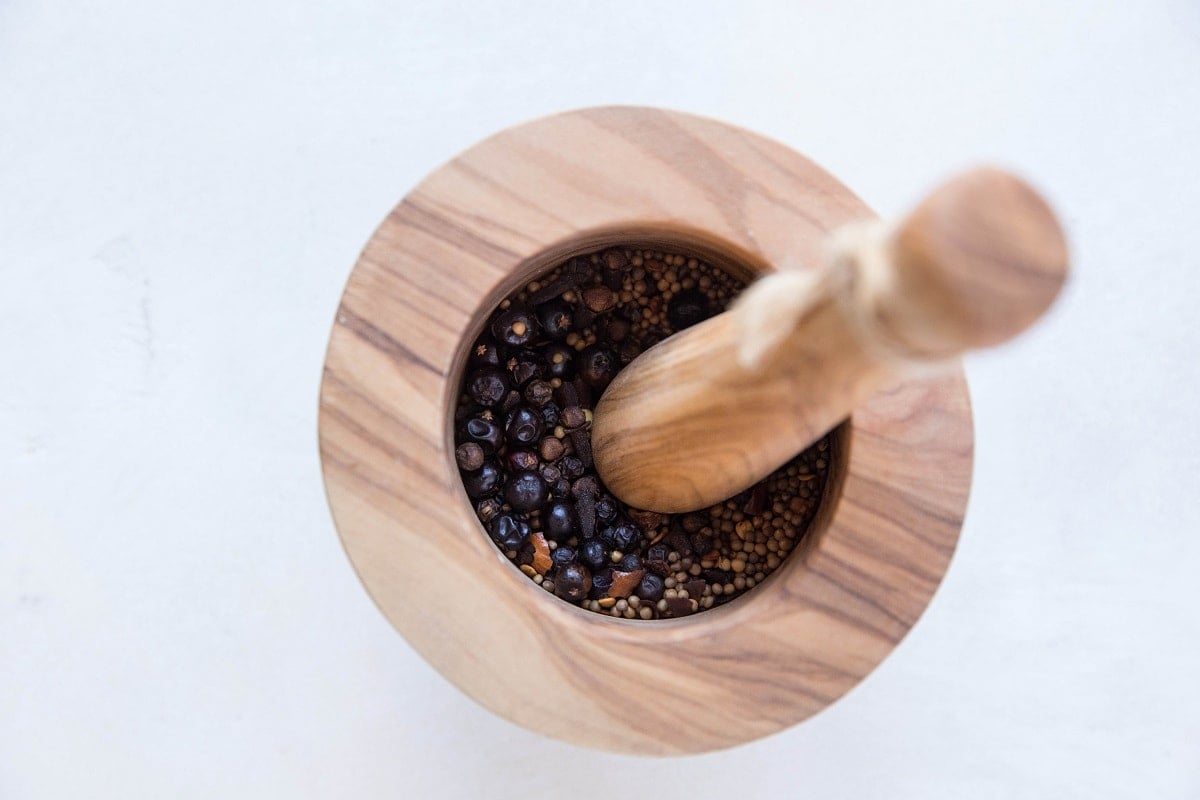
Add 1 gallon of water to a large pot and add the toasted pickling spices, coconut sugar, and salt. Bring everything to a full boil. Remove from the heat and stir in the honey.
Allow the brine to cool before transferring it to the refrigerator to finish chilling completely.
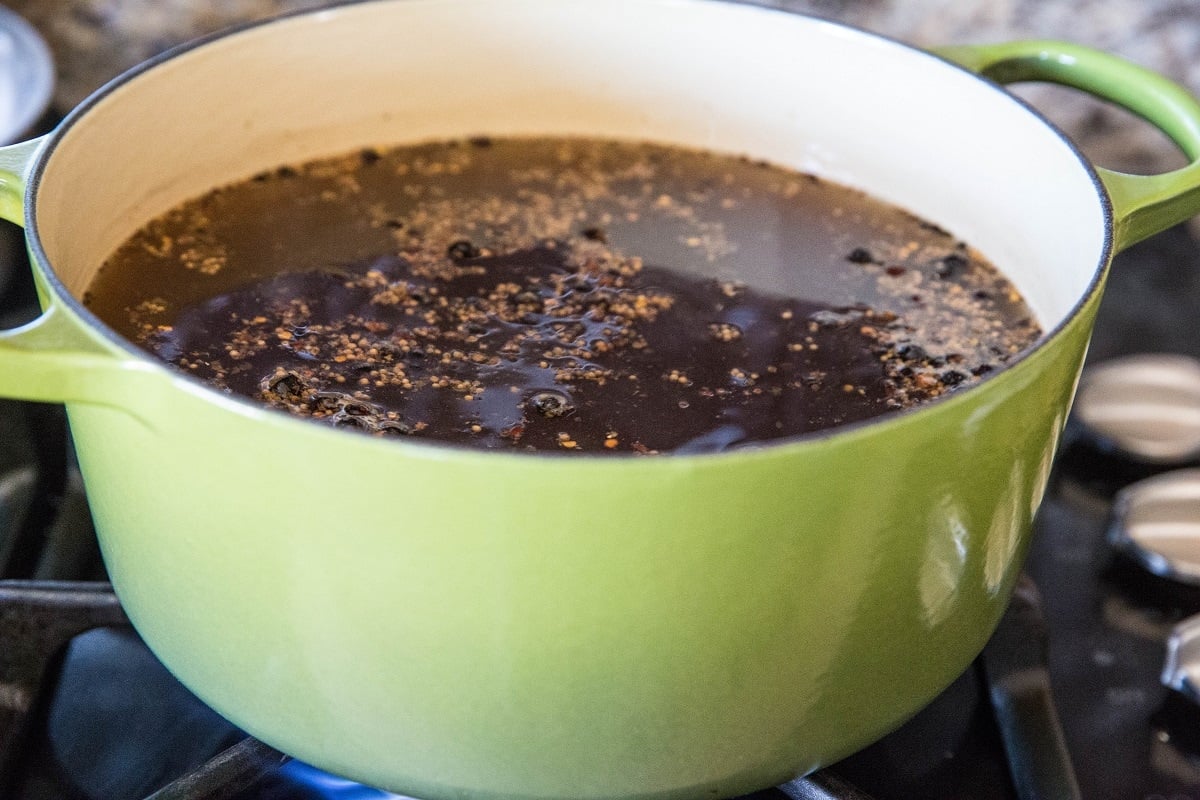
Step 2: Brine the Beef:
Transfer the beef to a large sealable container (you may need to cut the beef into two chunks and use two containers depending on its size).
Pour the brine over the beef such that the beef is fully covered in the liquid.
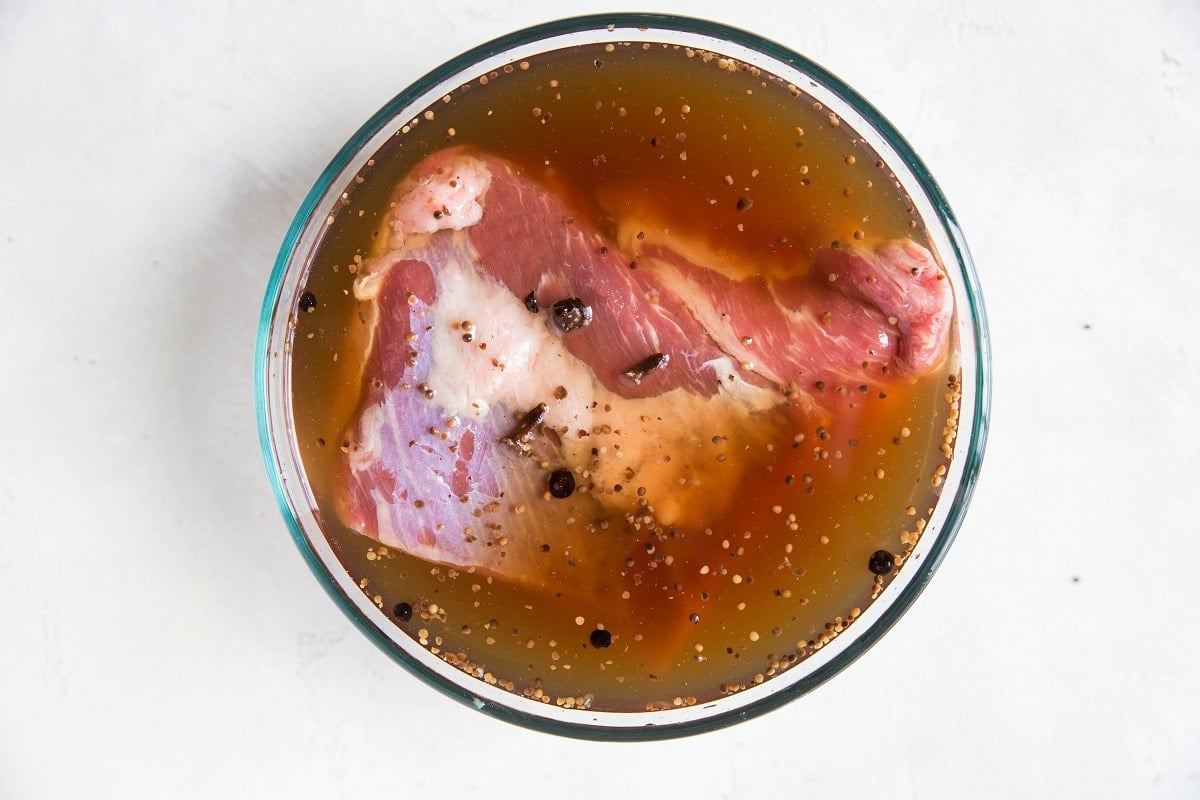
Seal the container(s) and keep in the refrigerator for 5 to 7 days.
Step 3: Cook the Pastrami:
Traditional pastrami is cooked on a smoker, but you can also cook it in the oven if you don’t own a smoker.
Smoker Instructions: Preheat your smoker to 225 degrees Fahrenheit. Rinse the meat and pat it dry with a paper towel. Place the meat in the smoker and allow it to smoke for 6 to 9 hours, or until the beef reaches an internal temperature of 200 degrees F. Note: smaller briskets will require less time, so base the timing off the internal temperature.
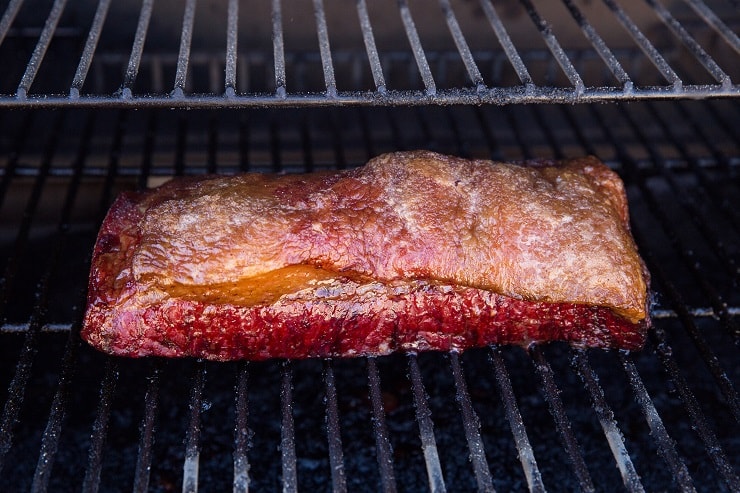
To Bake Pastrami: Preheat the oven to 300 degrees Fahrenheit. Rinse the meat under cool water and pat it dry with a paper towel. Place the meat in a large casserole dish or on a baking sheet. Roast for 1 hour per pound of meat (3 hours if your roast is 3 pounds), or until the beef reaches an internal temperature of 200 degrees F.
For the best result, be sure to use a meat thermometer to check the temperature of the pastrami periodically.
Allow the meat to cool before wrapping it in foil and storing it in the refrigerator until chilled. Once the pastrami is completely cold, you can slice it for sandwiches. Also feel free to serve the pastrami hot fresh out of the oven with side dishes if you’d like.
Do note that my oven instructions are not the traditional braising method that is typically used, but rather a quick and easy method that happens to result in perfect pastrami.
For the traditional version, use a roasting pan with a wire rack and pour the brine in the roasting pan, placing the beef on top of the wire rack. Then cover the pan with foil and roast until the beef reaches an internal temperature of 200 degrees F, typically 2 to 3 hours.
Allow the pastrami to cool to room temperature before wrapping it in foil and refrigerating. Allow the pastrami to chill completely before slicing thinly and enjoying in a sandwich.
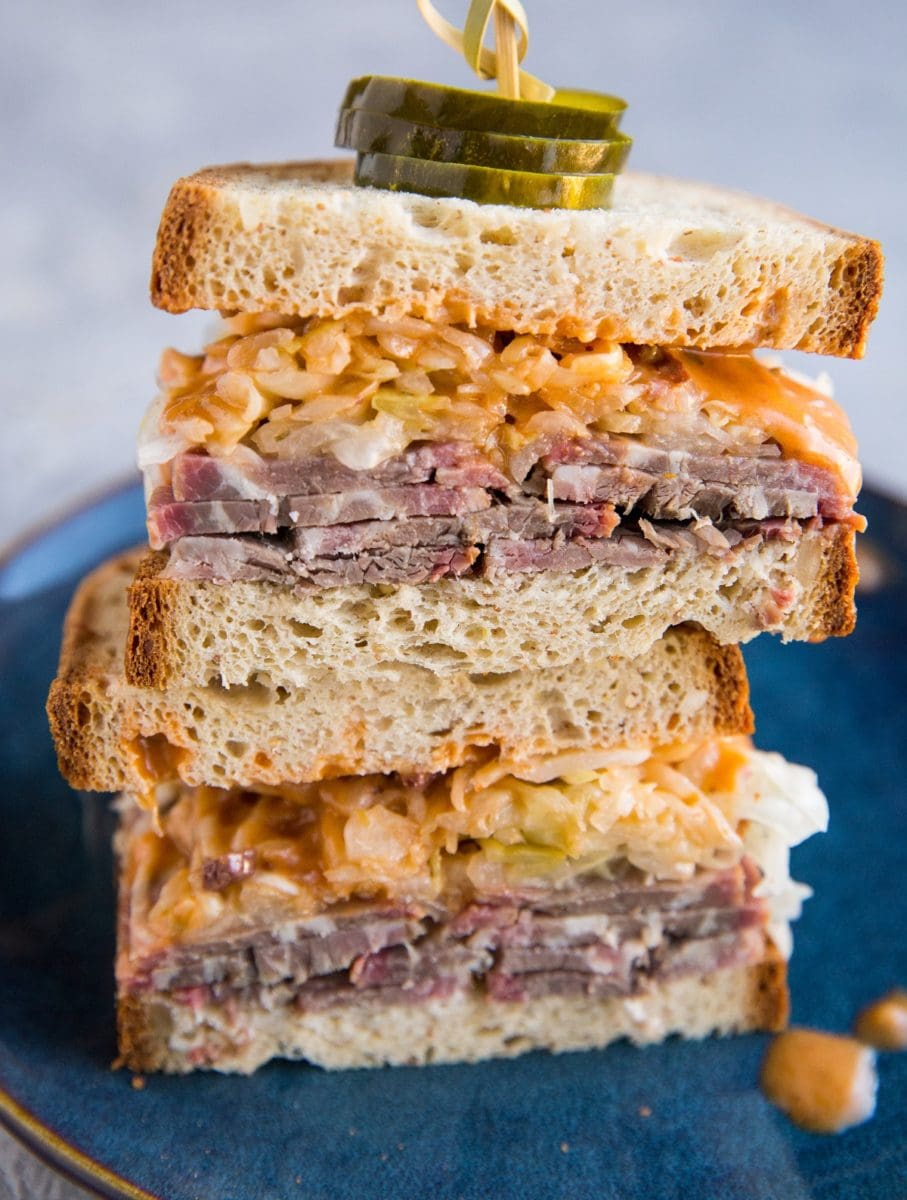
For my homemade Rueben, I go with gluten-free bread, sauerkraut, and Russian dressing. You can add Swiss cheese or your favorite cheese and toast it if you like hot pastrami sandwiches.
What to Serve with Pastrami:
- Sauteed Broccoli and Mushrooms with Crispy Bacon and Parmesan
- The Best Potato Salad
- Quick Pickled Vegetables
- Hawaiian Macaroni Salad
I hope you enjoy this nitrate-free pastrami!
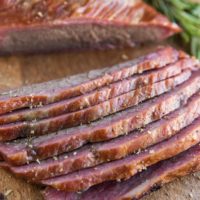
How to Make Pastrami (Nitrate-Free, Paleo)
Ingredients
- 1 5-pound beef brisket
- 1 gallon water
- 1 cup kosher salt
- ½ cup coconut sugar or regular brown sugar
- ½ cup honey
- 1 Tbsp yellow mustard seed
- 1 Tbsp juniper berries
- 2 tsp whole cloves
- 1 Tbsp whole black peppercorns
- 1 tsp red pepper flakes
- 1 Tbsp coriander seed
- 2 bay leaves
Instructions
Step 1: Prepare the Brine:
- Toast the spices in a small skillet or pot over medium-low to medium heat for 1 to 2 minutes, stirring occasionally. This process helps enhance the flavors of the spices so that the brine works magic on flavoring the beef.
- Transfer spices to a mortar and pestle and grind – it’s okay if they remain whole…you simply want to crush the spices to help them release flavor.
- Add 1 gallon of water to a large pot and add the toasted pickling spices, coconut sugar, and salt. Bring everything to a full boil. Remove from the heat and stir in the honey. Allow the brine to cool before transferring it to the refrigerator to finish chilling completely.
Step 2: Brine the Beef:
- Transfer the beef to a large sealable container (you may need to cut the beef into two chunks and use two containers depending on its size).
- Pour the brine over the beef such that the beef is fully covered in the liquid.
- Seal the container(s) and keep in the refrigerator for 5 to 7 days.
Step 3: Cook the Pastrami:
- Smoker Instructions: Preheat your smoker to 225 degrees Fahrenheit. Rinse the meat and pat it dry with a paper towel. Place the meat in the smoker and allow it to smoke for 6 to 9 hours, or until the beef reaches an internal temperature of 200 degrees F.
- Baking Instructions: Preheat the oven to 300 degrees Fahrenheit. Rinse the meat under cool water and pat it dry with a paper towel. Place the meat in a large casserole dish or on a baking sheet. Roast for 1 hour per pound of meat (3 hours if your roast is 3 pounds), or until the beef reaches an internal temperature of 200 degrees F.
- For the best result, be sure to use a meat thermometer to check the temperature of the pastrami periodically.
- Allow the meat to cool before wrapping it in foil and storing it in the refrigerator until chilled. Once the pastrami is completely cold, you can slice it for sandwiches. Also feel free to serve the pastrami hot fresh out of the oven with side dishes if you’d like.
Nutrition
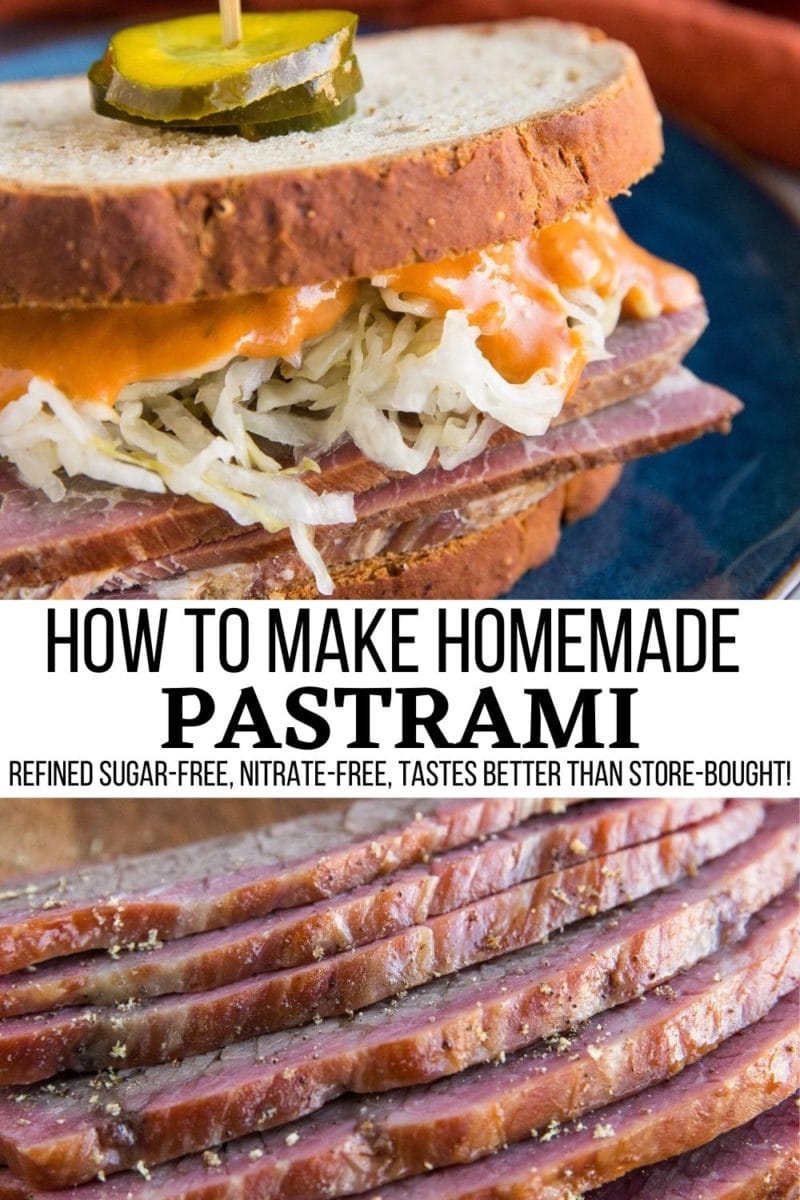

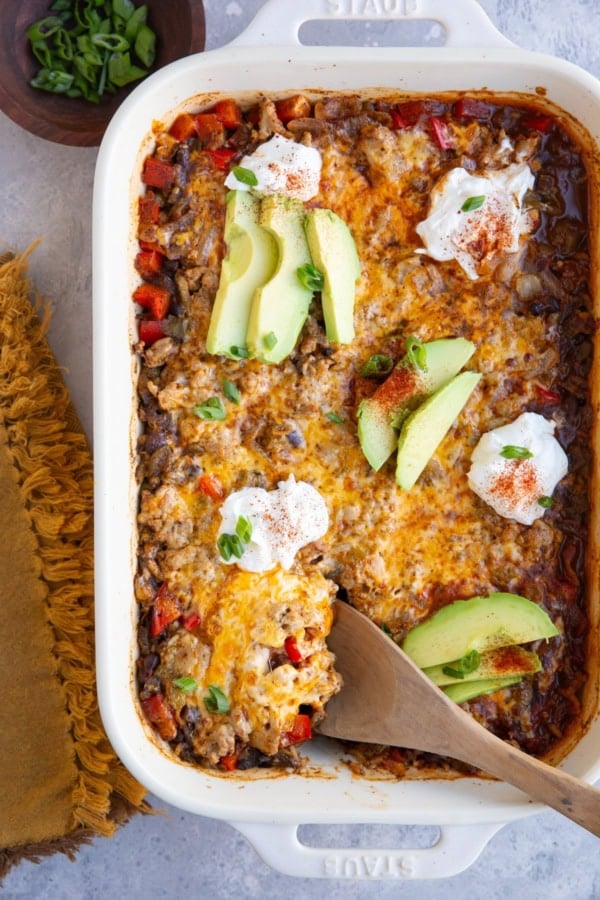
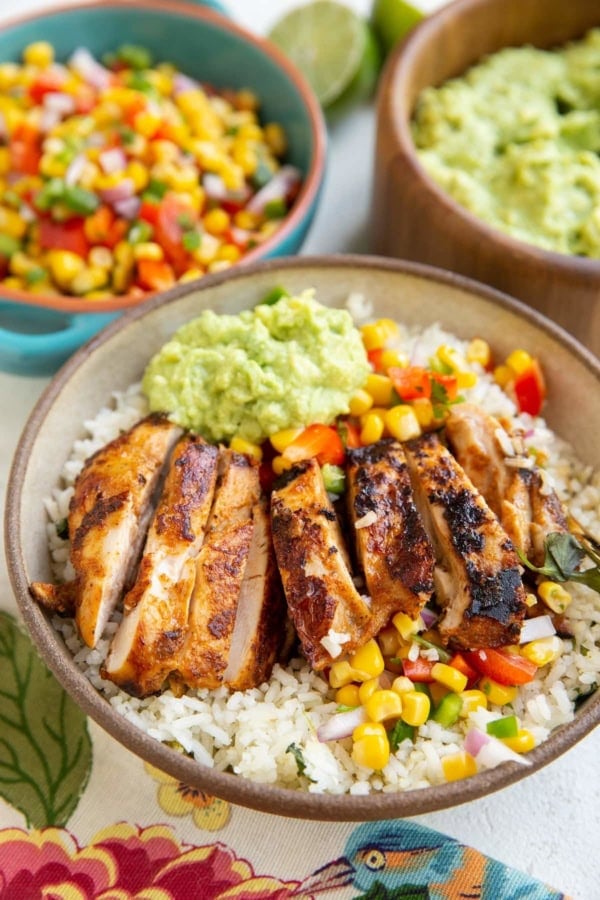
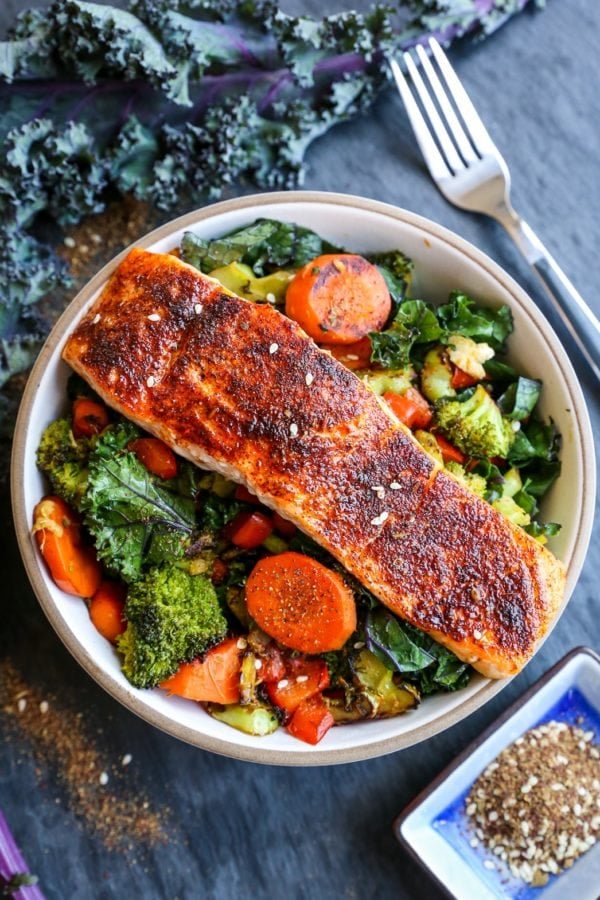
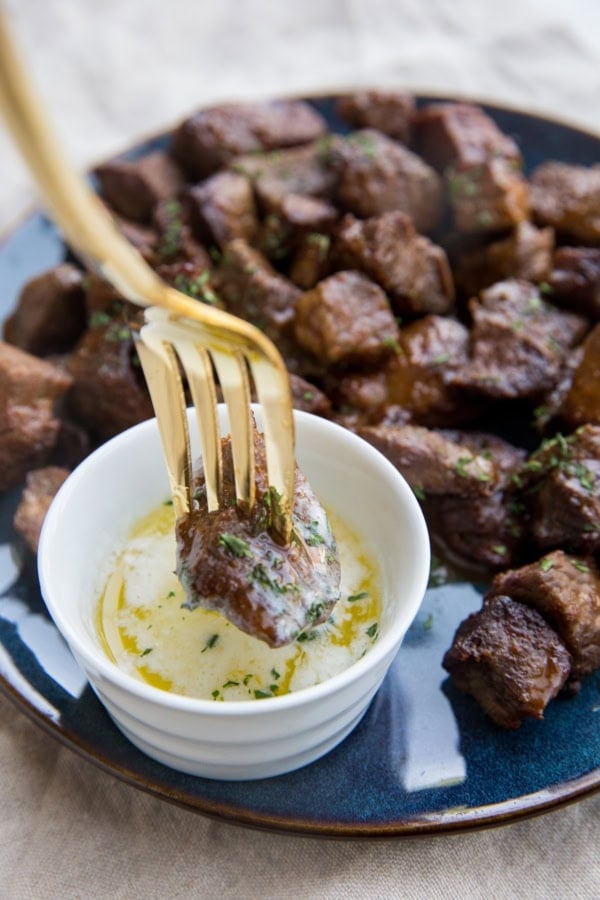









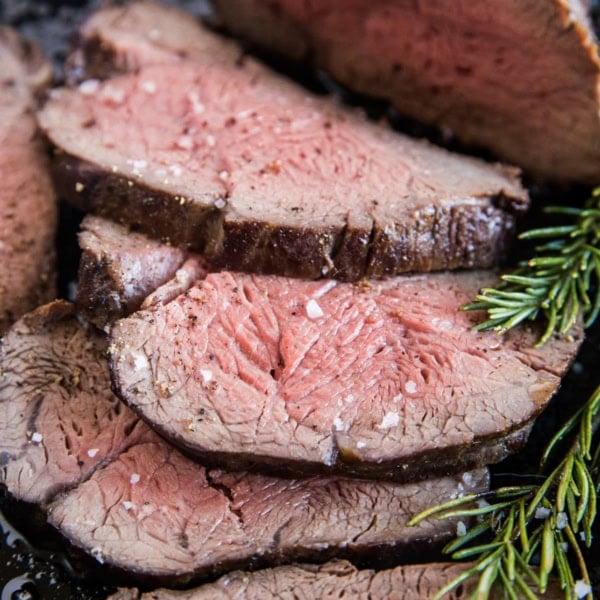
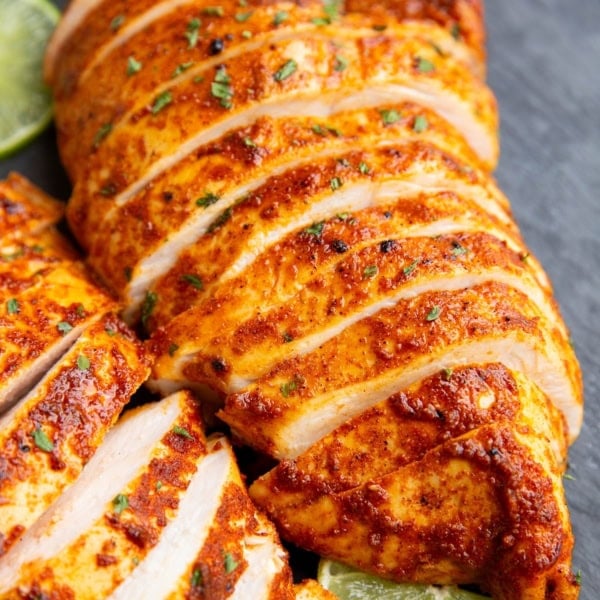
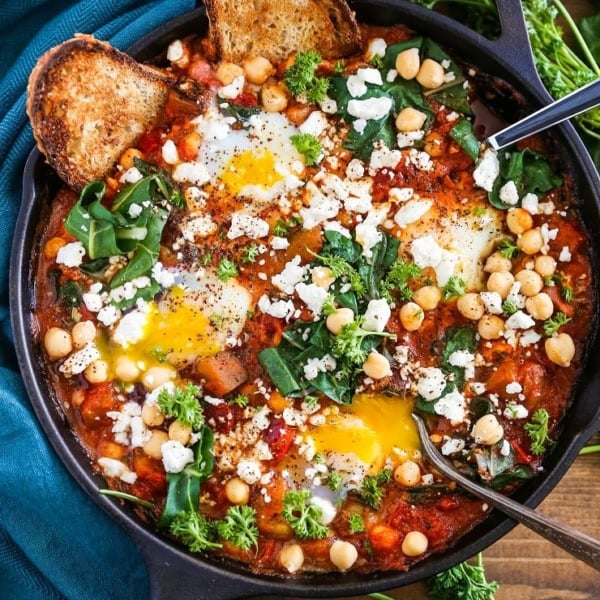
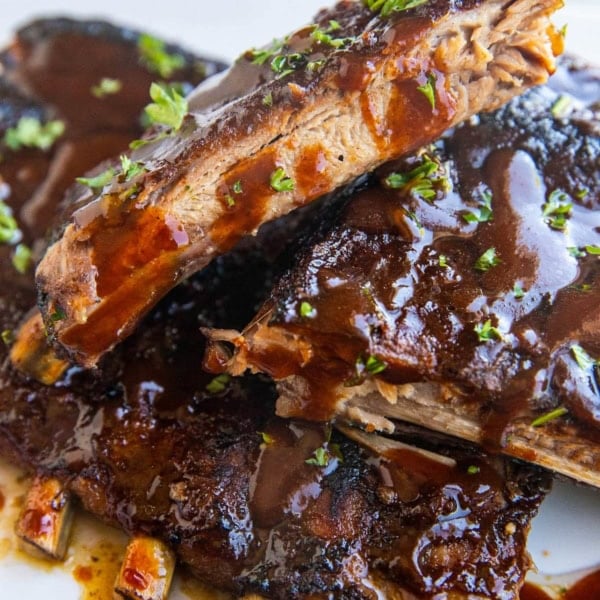
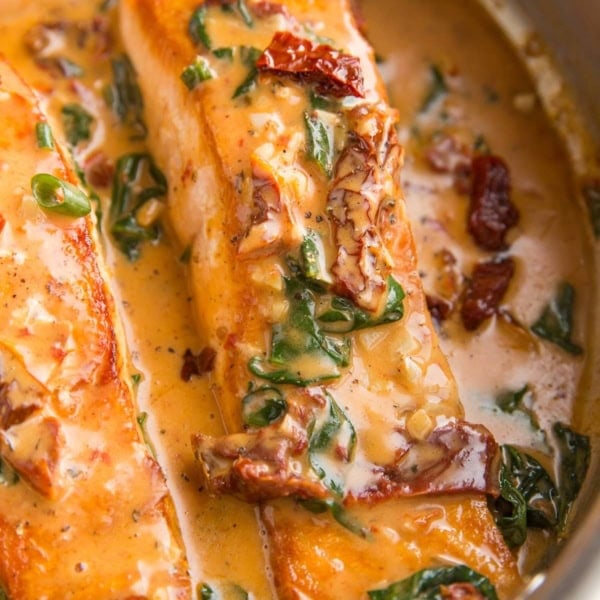
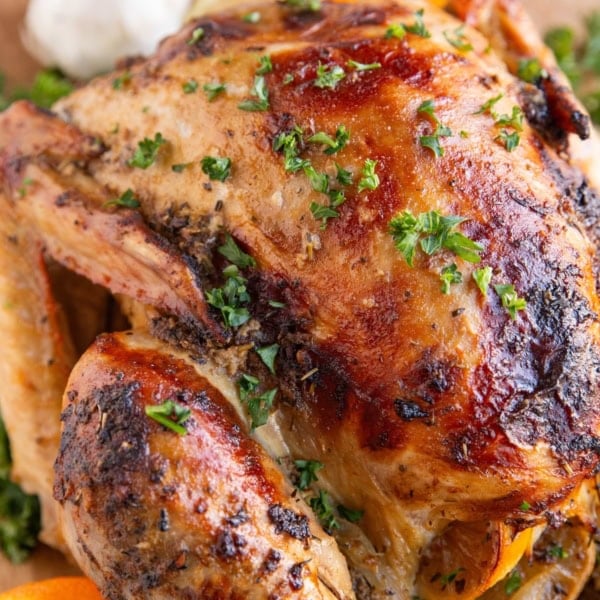
How’s the salt content in the final product? Would you recommend soaking the brisket after brining?
Not needed. Unreal recipe.
This uncured recipe looks interesting. Only comment I have is related to the length of time – a 5 lb brisket with an internal temp of 200F with smoker at 225F will take much longer than 2-3 hours.
Thank you for sharing, Steve! I looked back on a different smoked brisket recipe I’ve shared and realized I had smoked a 5-pound brisket for closer to 9 hours…a big difference! I’ll update this post, and I appreciate you catching my error 🙂
I’m a little confused about this recipe though I haven’t tried it. At the top the author says quite correctly that pastrami is cured, smoked then steamed. Yet the actual recipe mentions smoking or baking, then the author says in the comments “i love the idea of smoking, I bet that adds incredible flavor”. I thought all pastrami was smoked. No mention of steaming. When I make a similar meat (Montreal Smoked Meat), you only smoke it to about 170 degrees, then steam it to 203 for perfect, moist meat.
Hi Kerry! I can see the confusion – I don’t believe I made it clear in the post, but I followed the oven instructions for my pastrami. You can use either method (smoking or baking). I used the baking method because I know there are fewer people who have smokers than ovens. Let me know if you have any other questions!
Just made this for the first time. I used dark muscovado sugar, and did two versions. The first I baked as per instructions (actually over baked as my oven thermometer appears to be broken. The second, with a new thermometer, I smoked (pear wood) to an internal temp of 160F, and then baked to 200F. The first is really really good, but the smoked version is amazing.
Thank you for this. Will definitely make again.
Ooh, I LOVE the idea of smoking the pastrami! I bet that adds incredible flavor. Thanks so much for sharing, Jon! xo
If I brine a eye round roast with this brine recipe, can I cook it rare or medium?
Hi Edward! Based on my limited experience with brining, I would recommend only brining the roast for 1 day if you want to cook it to rare or medium. If it were me, I would be worried that brining it for 5-7 days and not cooking it through would result in some bacteria left in the meat. I’m not positive this would happen, but it would be my concern. So if you want to try the brine for one day, I would say you should be fine, otherwise, I would stick with the instructions of cooking it thoroughly 🙂 Hope you enjoy!
“Refined sugar free”???? 8 grams of sugar and how many carbs? Let’s see. 6 grams of carbs!!! Bad, bad, bad. Your refined sugar still causes the same insulin reponse. That means tht if someone has diabetes 2 they better AVOID this recipe.
Here is how I arrived at your web page. I googled, “Can you make pastrami without sugar?”
My complaint is simple. Your recipe title is MISLEADING.
The recipe title is: “How to Make Pastrami (Nitrate-Free, Paleo)”. How is that misleading? The recipe does not contain nitrates, and it is paleo friendly because it uses coconut sugar and honey instead of regular cane sugar. I never state in the post that the recipe is sugar-free, only refined sugar-free. Meaning we use a sweetener other than regular cane sugar, which is how pastrami is traditionally made.
It sounds like you were looking for a sugar-free/low-carb/keto pastrami recipe. In that case, you are correct – this recipe is not keto, low-carb or sugar-free. The fact that you landed on my site out of a google search for something other than what you were looking for doesn’t entitle you to leave a 1 star review. It’s not the fault of my site you didn’t get the search result you were looking for. Let me know if you have any questions.
@Julia, Absolutely agree! People need to READ! And A person CAN adjust this to use whatever sugar or NO sugar.
NO where did it say sugar free. I just made the brine and hope it turns out ok. I used my bison brisket instead of beef.
NOT your fault google gives bad search results!
Thank you for the NITRATE FREE recipe!
Thanks for coming to my rescue, Terri 😉 I really appreciate the sweet words! xoxo
It still has a TON of sodium, so not anything close to healthy!
Hi Sam. The sodium level an individual needs is completely subjective. I, for instance, workout daily and sweat profusely so my sodium needs are much higher than someone who doesn’t exercise as much. It’s important to keep in mind that each individual has unique dietary needs, and can make their own assessment of what is “good” or “bad” for themselves accordingly.
no one said it was healthy why would you even be eating pastrami if you were looking for healthy recipes or foods be fair to the poster for crying out loud
how long is it good in the fridge after you cook it? does it freeze well?
I keep it in an airtight container (or zip lock bag) in the refrigerator for two weeks. I’m betting it would last longer than that but we always eat it before the two week mark is up 🙂 Nevertheless if you’re going to keep it for longer than 2, I would freeze it at that point just to be safe. Yes, pastrami freezes very well! I’d keep it for up to 3 months in the freezer. For the best result, wrap it in plastic wrap tightly, then put it in a zip lock bag 🙂 Hope you enjoy! xo
I shared this recipe with friends who have a smoker and loves to make delicious meats. I do have an ulterior motive, I am hoping they share some with me. I am looking forward to my oven-cooked version.
LOL, keeping my fingers crossed they share with you too! Thanks for sending the recipe their way! xoxo